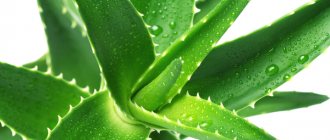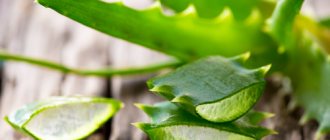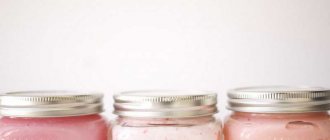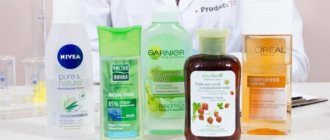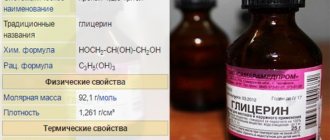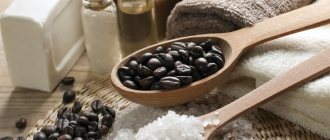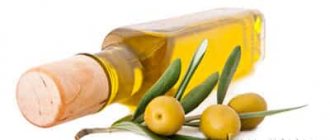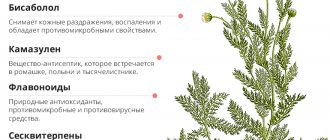Complete daily facial skin care consists of several stages: removing cosmetics (using cosmetic milk or gel), cleansing (tonic) and moisturizing (cream).
For the first and last stages, it is best to use professional cosmetics, but a natural facial tonic is simply irreplaceable for youthful skin. And one of the most effective tonics is moisturizing aloe lotion, which you can prepare at home.
Expert opinion
Useful advice from the editor
We talked more about the benefits of agave in home cosmetology in our exclusive review of homemade face masks with aloe
Compound
The secret of the high effectiveness of aloe as a medicine is in its unique composition. This is truly a rich cocktail of biologically active substances. The viscous greenish liquid with a pronounced herbaceous odor contains:
- antioxidants (vitamins C, E, etc.) – protect cell membranes from the destruction of free radicals and slow down the aging process;
- minerals and trace elements : potassium, magnesium, iron, phosphorus, zinc, copper, manganese – regulators of intracellular metabolic processes;
- B vitamins – substances that directly affect the condition of the skin;
- retinol – helps fight pigmentation, regulates the activity of the sebaceous glands;
- phytoncides - natural antibiotics that are destructive to fungi, bacteria and other microbes;
- amino acids – building materials necessary for new healthy cells;
- organic acids – improve subcutaneous blood circulation and work as exfoliators;
- tannins – regulate blood clotting, act antibacterial and anti-inflammatory.
Interestingly, fresh aloe juice is less valuable than that obtained after preliminary preparation of the leaves. I'll tell you how to do this correctly a little later.
How to prepare homemade leaves
To prepare a lotion for the skin of the face and body based on aloe juice, you need to carry out the correct preparatory “measures”:
- do not water the plant for 2 weeks;
- for work, use only the lowest, fleshy leaves;
- they are torn from the plant, thoroughly washed and dried;
- Having wrapped the selected parts of the aloe in paper (not tightly), they are placed in the refrigerator for at least 10 days.
Only after the specified period has passed can you begin to “extract” the juice. To do this, the leaves are crushed and poured with warm water in a ratio of 1:3, respectively. The mixture should stand for 2 - 3 hours in a non-metallic container with the lid closed, after which it is filtered/squeezed through cheesecloth.
The juice obtained in this way will need to be filtered again and poured into a resealable bottle/vial made of dark glass - this is the container in which the cosmetic product is stored (in the refrigerator for a maximum of 2 weeks).
The result of this process will be the production of biostimulated juice - under the influence of low temperatures and in the absence of light, the active substances in aloe leaves are activated and accumulate.
Plant properties
Thanks to this unique composition, which, according to modern research, includes more than 200 chemical elements and their compounds, aloe juice has a quick and powerful healing effect on the skin and the entire body:
- strengthens the immune system;
- improves cellular nutrition;
- provides additional oxygen flow;
- acts anti-inflammatory and antibacterial;
- slows down age-related destructive processes;
- neutralizes damage from free radicals;
- serves as a prevention of tumors;
- helps get rid of pimples and acne;
- eliminates bruises and swelling, including under the eyes;
- promotes healing of wounds and cracks;
- deeply moisturizes and nourishes the skin;
- reduces symptoms of dermatitis, eczema, psoriasis.
It was also noticed that preparations with aloe perfectly refresh and rejuvenate the skin. It is because of this that the plant has become so widely used in professional cosmetology, and not just in folk cosmetology.
Cosmetics with aloe
Given the rich chemical composition of aloe, it is not surprising that most body and facial care products contain extract of this plant.
Hydra Genius aqua fluid with aloe from L'Oréal
Great for those with sensitive and dry skin. The product consists of more than 70% water.
The formula is enriched with hyaluronic acid, aloe juice and other beneficial components that give the skin youthfulness and radiance and deeply moisturize.
It has a light consistency that is instantly absorbed and does not leave a greasy sheen or stickiness.
The product intensively fills the epidermis with moisture and keeps it hydrated for 72 hours. Effectively eliminates irritation, softens, stimulates cellular renewal and the production of elastin and collagen.
It is recommended to apply the product morning and evening to cleansed skin, and also use it as a base for makeup so that the tone goes on evenly.
Moisturizing and soothing gel with aloe from Holika Holika
This Korean cosmetics helps maintain optimal moisture levels in the epidermis.
Suitable for dry, sensitive skin. The active ingredients quickly soften, moisturize the skin, relieve inflammation, itching, and irritation.
The product is instantly absorbed by the epidermis and does not leave a sticky or greasy film. Apply 1 r. per day with light patting movements.
Nature Republic Aloe Moisturizing Essence
This is another quality Korean product. Increases the protective forces of the epidermis, prevents the penetration of bacterial infections.
Suitable for dehydrated skin that is constantly bothered by a feeling of tightness, dryness, and irritation. The product replenishes moisture reserves, saturates with vitamins, minerals, and amino acids.
Stimulates blood flow and oxygen delivery to tissues. Apply 3 drops of essence to the skin of the face and spread with patting movements.
After the product is absorbed, apply a moisturizer, preferably from the same brand (gel cream from Nature Republic).
Preparing the lotion
Concentrated aloe juice is a very powerful drug. In its pure form, it is applied mainly to treat wounds and severe inflammatory processes.
For regular care, it is much more convenient and beneficial to use it as part of masks or tonics. Remember that you must prepare, store and use the lotion correctly.
Preparation of concentrate
Stores usually sell aloe vera toner. This is one of the varieties of this medicinal plant. It is believed that it is the most useful and richest in biologically active substances. But at home, the so-called agave or aloe vera is more often used.
To obtain concentrated aloe juice at home, only the lower leaves, healthy and dense, from a plant that is at least 3-4 years old are suitable. They manage to accumulate useful substances in sufficient quantities.
The procedure for obtaining it looks like this:
- A couple of weeks before you plan to cut the leaves, stop watering the plant.
- 2-3 days before cutting it is placed in a cool, dark place.
- The leaves are cut off with a very sharp knife at the very trunk, and the wounds are immediately covered with earth.
- They are then wrapped in foil or clean cotton cloth and placed in the refrigerator.
- The exposure time for leaves in darkness and coolness is from 2 to 30 days.
- Then the leaves are cut lengthwise and the jelly-like pulp is scraped out with a plastic knife or spoon.
- It is squeezed well through several layers of gauze into a sterilized container.
This is the most valuable biological raw material. It is strictly forbidden to take it orally in its pure form. It can cause severe bleeding and even anaphylactic shock.
Usually the juice is diluted with water in a ratio of 1:2 or 1:3. Clean raw materials are stored in tightly closed containers in the refrigerator for up to 30 days.
Tonic recipes
Using pure juice, you can easily and quickly prepare a facial tonic with aloe. Here are some simple but very effective recipes:
- Classical. Concentrated aloe juice is simply diluted with distilled water in a ratio of 1:3. You can wipe your face with it up to three times a day.
- Bleaching. Dilute the concentrated juice in a ratio of 1:3 with freshly squeezed cucumber juice. Add a tablespoon of vodka and two teaspoons each of almond and olive oils. Use in the evenings on clean, dry skin.
- Refreshing. Aloe juice is diluted not with water, but with strong green tea. Add a teaspoon of vitamin E oil solution and 5-6 drops of mint essential oil to the composition. The product is suitable for pale, tired, aging skin.
- Against blackheads . For one part aloe juice, take two parts water or oak bark decoction and one part vodka. This composition perfectly cleanses and tightens pores, but dries out the skin. Therefore, it is only suitable for oily and combination skin types. Apply 3-4 times a week.
- Anti-inflammatory . Aloe juice is diluted in a 1:3 ratio with rose water. Add a tablespoon of plantain leaf juice and 5-6 drops of sage essential oil to it. The product relieves redness and itching, reduces the manifestation of rosacea.
- Moisturizing. Mix aloe juice in equal proportions with cucumber juice and add a tablespoon of glycerin. Great for dry and thin skin. It is not used in winter, since heating devices are actively operating during this period.
- Universal. It has nourishing, drying, anti-inflammatory properties. We dilute aloe juice with a pre-prepared decoction of three herbs: chamomile, calendula and sage.
Of course, there are many more recipes. Over time, you will learn to add other beneficial ingredients to aloe juice that are necessary specifically for your skin.
This raw material has another unique feature. It lies in its excellent compatibility with almost all components usually present in folk masks.
Benefits of aloe for skin
Science knows many varieties of plants, but in the cosmetology industry they most often use tree and aloe vera - they grow in almost every home. The composition of their leaves is unique: minerals and vitamins, amino acids and trace elements, polysaccharides and enzymes, enzymes and lingins. These components are so successfully combined in the plant that they can have the following beneficial effects on the skin:
- Hydration . It occurs in an intensive mode, which causes the restoration of water balance. Cosmetologists consider the plant effective for taking preventive measures against skin dehydration and early aging.
- Increasing the amount of naturally produced collagen fibers. This happens thanks to fibroblasts contained in the juice from aloe leaves. An increase in the amount of elastin and collagen in the skin leads to smoothing and rejuvenation, and slight tightening.
- Protects skin from harmful ultraviolet rays. If you regularly use products made with the pulp or juice of the plant, a thin protective film will form on your face. It does not allow the sun's rays to penetrate into the deep layers of the dermis, thereby preventing excessive pigmentation and dryness.
Separately, it is worth considering the disinfecting, healing, anti-inflammatory properties of the plant. They ensure rapid healing of any damage to the skin, relief of the inflammatory process, and reduction in the intensity of rashes (pimples, pustules).
Aloe juice helps with psoriasis, blackheads, and eczema. It does not cure, but acts as an additional therapy, which ensures the absence of intense manifestations of diseases.
The high qualities and abilities of the indoor plant make it safe and useful for any type of skin, but it is especially effective when caring for skin with problems - there is a tendency to allergies, frequent irritations, periodic rashes, and so on.
We recommend reading about facial skin lotion. You will learn about effective facial lotions, instructions for use, and preparation at home. And here is more information about folk remedies for moisturizing the skin.
Advantages and disadvantages
I am often asked what is better: buying a ready-made aloe vera toner in the store or making it yourself at home? It is very difficult to answer this question unambiguously.
The advantages of natural lotion include the complete absence of preservatives and a higher concentration of juice. But these are, perhaps, all its advantages over the finished product.
High-quality cosmetic product:
- has a longer shelf life;
- contains other useful additives;
- has significantly higher efficiency;
- more convenient to use;
- does not lose its healing properties.
The use of homemade lotion for medicinal purposes is justified. But for preventive purposes it is better to use ready-made cosmetic preparations. Naturally, from trusted manufacturers or professional ones.
Frozen agave juice
For facial care, you can use not only liquid or creamy products based on agave. Cosmetic ice works well and can be easily prepared at home. First, you should make a herbal decoction based on your skin type, and then use it to get ice:
- oak bark and calendula are suitable for oily skin;
- dry skin will need linden, rose petals or raspberry.
You need to add a little agave juice to it, pour it into molds and put the future cosmetic ice in the freezer. It is necessary to wipe your face using this product every day after washing your face in the morning. After this, it is not recommended to wipe the skin. Ice with aloe juice can also be made with the addition of flower water. Be sure to wipe the skin of your neck and décolleté. Cosmetic ice made from aloe juice can significantly increase skin elasticity, remove fine wrinkles and prolong skin youth.
Contraindications
Aloe juice has high biological activity. Even when used externally, it can have an effect on the entire body. Therefore, its use is contraindicated in:
- pregnancy and lactation;
- liver diseases;
- cystitis and menstruation;
- ulcers in the stomach and intestines;
- poor blood clotting;
- cardiovascular problems;
- exacerbation of chronic diseases.
Allergies to aloe lotion are quite rare. And yet, before using it for the first time, you must do a test to avoid unpleasant surprises.
How to apply?
- Apply the lotion to previously cleansed facial skin. We skip the eye area with thin and vulnerable skin. We wipe the neck and chest.
- For prevention, it is enough to apply the lotion once a week. For medicinal purposes, the cosmetic is applied every day. The course lasts one and a half months.
Important! Before using aloe lotion for the first time, you must make sure that you are not allergic to the plant.
Summing up
Making aloe juice lotion at home is quite easy. Therefore, those who do not trust store-bought products can pamper their skin with this useful composition.
Don't forget about the short shelf life. The principle is this: the more additional ingredients, the sooner the composition loses its healing properties.
I will be glad if you would like to share your opinion in the comments about which aloe tonic is better: homemade or store-bought. Tell us which recipe you liked best.
Remember that the addictive effect has not been canceled. 1-2 months after using the lotion, you should take a break for 3-4 weeks.
Rules for using funds
The juice can be used either pure or diluted. It is also used to prepare lotions and other cosmetics. The natural product is hypoallergenic, but in some cases it can cause redness, irritation, burning and itching when applied to the skin. In this case, experts recommend diluting the juice with boiled water in a 1:1 ratio, but if these symptoms do not disappear, then you should stop using the product.
If the lotion is used on oily, problem skin, then the use of a nourishing cream will be required - immediately after cleansing the dermis, the beneficial substances of such a product will be able to penetrate into the deep layers of the epidermis.
About the benefits of aloe and the rules of use for facial care, watch this video:
Homemade facial cleanser with aloe gel and avocado oil
This biological product is suitable for washing. It does not contain detergents, however, it carefully and carefully removes all impurities from the epidermis, including decorative cosmetics, while nourishing, healing, saturating with nutrients, refreshing, and moisturizing the skin.
To prepare the cleanser, combine 50 grams of ready-made or homemade aloe vera gel with 50 ml of avocado oil and 5 drops of lavender essential oil. The mixture is used for washing twice a day. Store in the refrigerator in a glass container.
Aloe Vera at home. Aloe Vera in nature and at home
Before aloe conquered our window sills, settling there under the name "agave", its habitat was hot countries - South America, Africa and the island of Madagascar, the Arabian Peninsula.
True, we might not recognize the plant if we met it in its natural environment - it is very different in appearance from the flowers we are used to with watery-green leaves. Wild specimens reach fifteen meters in height, shoot a long arrow from a rosette of leaves, at the end of which you can see a fiery red or bright yellow flower. Unfortunately, some species, such as Aloe Helena and Aloe Suzanne, are facing extinction.
In countries where aloe is grown professionally, entire hectares are planted with it (approximately 15,000 plants per 1 hectare), and the leaves are collected no more than three times a year. The use of pesticides to fertilize the soil is strictly prohibited.
Botany includes more than five hundred plant species. At home we can grow aloe vera, aloe vera and others. They are about equally easy to care for.
Types of aloe
- Aloe Vera (Barbados). The plant has a short stem on which there is a rosette of succulent and hard leaves. It forms an inflorescence like a brush and forms a peduncle up to 90 cm long. It blooms with yellow and sometimes red flowers.
- Aloe arborescens. The tall stem of the plant forms many shoots and has narrow and fairly succulent leaves.
- Aloe folded. A small tree with a short trunk, on which elongated leaves grow in the amount of 10–16 pieces.
- Aloe is awesome. The plant is distinguished by fleshy and thick leaves, with small red-brown thorns. It blooms with scarlet flowers collected in a spike-shaped inflorescence;
- Aloe spinosa. A distinctive feature of the plant is its large, numerous and thick leaves with soft and transparent thorns. A white border runs along the edge of the leaf blade.
Aloe lotion to tighten pores. Variety of aloe species
Aloe (colloquially often called agave) is a very diverse plant. Some sources claim that there are up to 350 species of it on the globe. These can be either small ornamental plants or huge trees.
A distinctive feature of aloe is its leaves. These are fleshy sword-shaped formations with sharp spines along the edges. They have the ability to accumulate moisture in large quantities, sometimes reaching enormous sizes. Aloe leaves have a special structure. They consist of three layers: the skin, a yellowish layer and the inner part (pulp).
- The skin serves to retain moisture inside the leaf.
- The second, fleshy layer contains a large amount of a substance called Aloin.
- The inner layer is a gelatinous liquid called Aloe Gel.
Of the huge variety of varieties, only about 15 of them are used for medicinal purposes. Most often, aloe leaves of the following types are included in facial compositions:
- Real aloe or, as it is more often called, aloe vera. The plant has large fleshy leaves that can reach a meter in length and up to 15 cm in width. Plants that are at least 4-5 years old are used for medicinal purposes.
- Aloe arborescens. An African plant species, widespread in Russia. Reaches a size of no more than a meter. Dried juice is produced from it - sabur.
- Aloe Sokotra. The height of plants in natural conditions can reach 3-5 meters. Sheet length up to 1 meter. The plant juice is used as a raw material for the cosmetic and pharmaceutical industries.
Recipe No. 2
Grind 100 gr. aloe leaves, put in an enamel pan, stainless steel or fireproof glass and pour cold boiled water (1 liter). Place in a cool place for 2 hours. Then bring to a boil in a water bath, simmer for 5 minutes and set aside until completely cooled. Strain the liquid through cheesecloth and squeeze out the leaf pieces well. Pour into a glass bottle or jar and close tightly. Shelf life – 1 week.
Wipe the skin with lotion daily before going to bed. You can apply compresses every 2-3 days. To do this, soft cotton cloth or cotton swabs are soaked in lotion and applied to the desired areas for 10 minutes. Designed for mature and aging skin.
